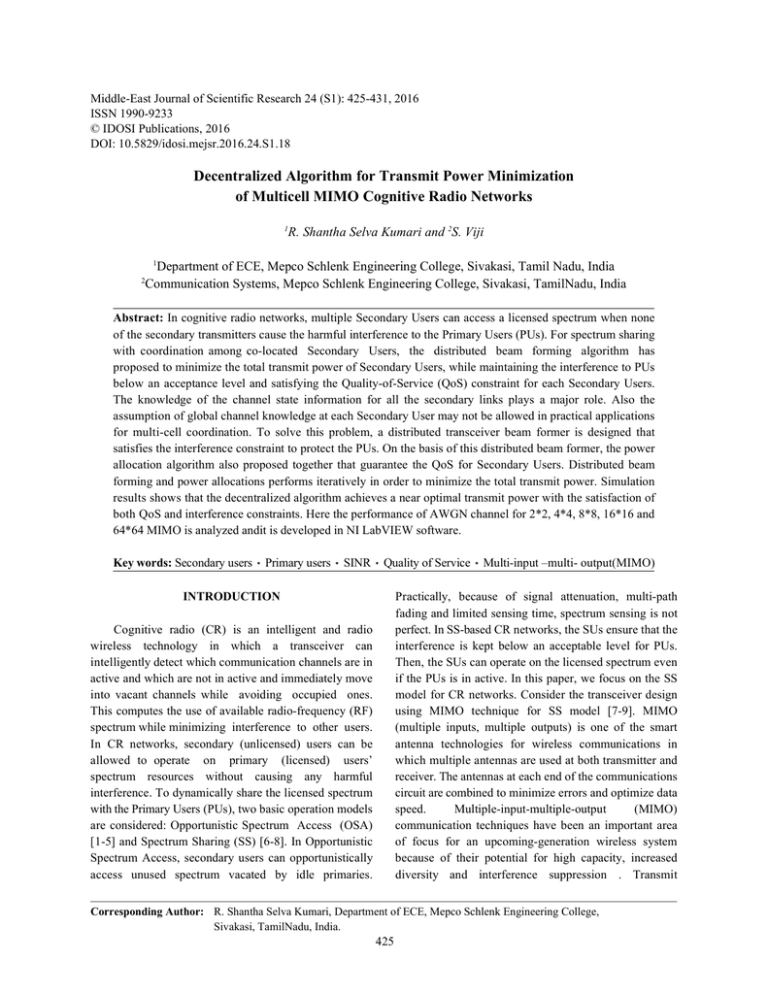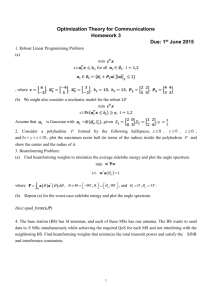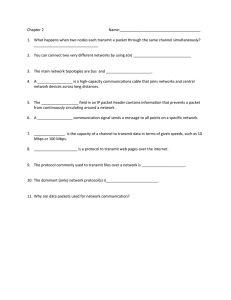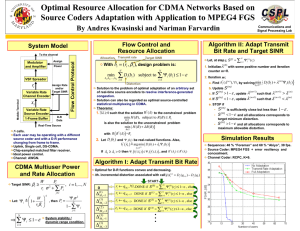Full Text
advertisement

Middle-East Journal of Scientific Research 24 (S1): 425-431, 2016 ISSN 1990-9233 © IDOSI Publications, 2016 DOI: 10.5829/idosi.mejsr.2016.24.S1.18 Decentralized Algorithm for Transmit Power Minimization of Multicell MIMO Cognitive Radio Networks 1 R. Shantha Selva Kumari and 2S. Viji Department of ECE, Mepco Schlenk Engineering College, Sivakasi, Tamil Nadu, India Communication Systems, Mepco Schlenk Engineering College, Sivakasi, TamilNadu, India 1 2 Abstract: In cognitive radio networks, multiple Secondary Users can access a licensed spectrum when none of the secondary transmitters cause the harmful interference to the Primary Users (PUs). For spectrum sharing with coordination among co-located Secondary Users, the distributed beam forming algorithm has proposed to minimize the total transmit power of Secondary Users, while maintaining the interference to PUs below an acceptance level and satisfying the Quality-of-Service (QoS) constraint for each Secondary Users. The knowledge of the channel state information for all the secondary links plays a major role. Also the assumption of global channel knowledge at each Secondary User may not be allowed in practical applications for multi-cell coordination. To solve this problem, a distributed transceiver beam former is designed that satisfies the interference constraint to protect the PUs. On the basis of this distributed beam former, the power allocation algorithm also proposed together that guarantee the QoS for Secondary Users. Distributed beam forming and power allocations performs iteratively in order to minimize the total transmit power. Simulation results shows that the decentralized algorithm achieves a near optimal transmit power with the satisfaction of both QoS and interference constraints. Here the performance of AWGN channel for 2*2, 4*4, 8*8, 16*16 and 64*64 MIMO is analyzed andit is developed in NI LabVIEW software. Key words: Secondary users Primary users SINR Quality of Service INTRODUCTION Multi-input –multi- output(MIMO) Practically, because of signal attenuation, multi-path fading and limited sensing time, spectrum sensing is not perfect. In SS-based CR networks, the SUs ensure that the interference is kept below an acceptable level for PUs. Then, the SUs can operate on the licensed spectrum even if the PUs is in active. In this paper, we focus on the SS model for CR networks. Consider the transceiver design using MIMO technique for SS model [7-9]. MIMO (multiple inputs, multiple outputs) is one of the smart antenna technologies for wireless communications in which multiple antennas are used at both transmitter and receiver. The antennas at each end of the communications circuit are combined to minimize errors and optimize data speed. Multiple-input-multiple-output (MIMO) communication techniques have been an important area of focus for an upcoming-generation wireless system because of their potential for high capacity, increased diversity and interference suppression . Transmit Cognitive radio (CR) is an intelligent and radio wireless technology in which a transceiver can intelligently detect which communication channels are in active and which are not in active and immediately move into vacant channels while avoiding occupied ones. This computes the use of available radio-frequency (RF) spectrum while minimizing interference to other users. In CR networks, secondary (unlicensed) users can be allowed to operate on primary (licensed) users’ spectrum resources without causing any harmful interference. To dynamically share the licensed spectrum with the Primary Users (PUs), two basic operation models are considered: Opportunistic Spectrum Access (OSA) [1-5] and Spectrum Sharing (SS) [6-8]. In Opportunistic Spectrum Access, secondary users can opportunistically access unused spectrum vacated by idle primaries. Corresponding Author: R. Shantha Selva Kumari, Department of ECE, Mepco Schlenk Engineering College, Sivakasi, TamilNadu, India. 425 Middle-East J. Sci. Res., 24 (S1): 425-431, 2016 beamforming was introduced to provide efficient dynamic spectrum access in various CR MIMO scenarios, including uplink transmissions from the Sus to the S-BS are usually modeled by a multiple-access channel (MAC), at the same time the downlink transmissions from the S-BS to different SUs are modeled by a broadcast channel (BC) .Also an iterative beamforming algorithm for CR-MIMO-BCs was proposed to minimize the total transmit power, while satisfying the Quality of Service (QoS) for SUs and the interference constraint to protect PUs [10]. The Second-Order Cone Programming (SOCP) was formulated, to efficiently solve the problem of joint power allocation and beamforming. In addition, transmit and receive beamformers were obtained by using the uplink downlink duality, which makes it possible to transform a primal problem in MIMO-BC into a dual problem in MIMO MAC [11]. In [12], it is proposed that an iterative algorithms for power allocation and transceiver beamforming over CR-MIMO-ICs, where multiple secondary systems coexist with the primary systems. The proposed algorithm minimize the transmit power, while satisfying both the QoS and the interference constraints. Finally we formulate a joint optimization problem of power allocation and beamforming, which is extended from the single cell case in to multi-cell cases by using the network duality of MIMO-IC. The optimal solution of the problem provides the minimum total transmit power, but requires knowledge of the Channel State Information (CSI) for all the secondary systems. For practical applications, the assumption of global channel knowledge may not be allowed in multi-cell coordination because of the complexity constraint of backhaul [13]. Here, we decompose the joint optimization problem into two sub-problems: transmit power allocation with the QoS constraint for the secondary systems and distributed beamforming with the interference constraint for the primary systems. Power allocation and distributed beamforming iteratively operate to achieve both the minimum transmit power and the QoS requirement, while the interference to the primary systems is always kept below the acceptable level. At each iteration, transmit and receive beamformers increase the Signal to Interference and Noise Ratio (SINR) of each secondary system [14], without knowledge of the global CSI. secondary system with the constraints of transmit power for secondary systems and interference power for the primary system , [15]. The other is the transmit power minimization of secondary systems under their minimum QoS constraint and the interference constraint for the primary system. In , a joint transceiver beamforming over MIMO cognitive radio networks is proposed to minimize the transmit power while satisfying target SINR for the SUs and maintaining an acceptable interference level to the PUs. We begin by assuming perfect CSI of primary and secondary links at the SBS, and also provide robust extensions for the imperfection CSI cases. Dynamic resource allocation (DRA) becomes an essential technique for CRs to optimally deploy their transmit strategies to maximize the secondary network throughput, where it dynamically allocated the transmit power, bit-rate, bandwidth and antenna beam based upon the available channel state information (CSI) of the primary and secondary networks. The uplink transmissions from the S-MS to the S-BS are usually modeled by a multipleaccess channel (MAC), while the downlink transmissions from the S-BS to different S-MS are modeled by a broadcast channel (BC).The significant problem of designing schemes to efficiently control the transmit power of CR systems to not only make best use of their resource but also avoid interrupting the PU’s communication in multiple input single output (MISO) environment, which usually reflects the practical scenario of base stations with multiple antennas and mobiles with single antenna. Conventional multiple antenna base stations have the property to achieve SINR of each receiver and minimize their power consuming by implementing joint transmit beamforming and power control algorithms. Notations Used: ||.||2, I, (.)*, (.)T, (.)Hdenotesl2-norm, identity matrix conjugate, transpose and conjugate-transpose, respectively. System Model: We consider a cognitive radio network consisting of L primary and K secondary systems, as illustrated in Fig. 1. The primary BS and MS contain NPand MPantennas, respectively. At the cell edge of secondary systems, the BS MS pairs form a K-user MIMO-IC with L primary systems, where the kth secondary BS and MS are equipped with Nkand M antennas, k respectively. Related Works: For SS-based CR networks, there are two fundamental criteria involved in optimizing the beamformer. One is the throughput maximization of the 426 Middle-East J. Sci. Res., 24 (S1): 425-431, 2016 (2) Pri BS G21 G21 H21 Sec BS1 where ij R+ and Hij CMi×Nj are a pass loss component and channel matrix between BS j and MS i in the secondary system, respectively. nk is channel noise with zero mean and the variance of 2N at secondary MS k, i.e., nk ~CN (0, 2N). In CR networks, it is usually difficult for each secondary MS to measure the exact interfering power from the primary BS, because of the loose cooperation between the primary and the secondary systems. To satisfy the minimum QoS constraint of the secondary system, the maximum interfering power can be considered as the worst case. Let 2I be the maximum interfering power from the primary BS to the secondary MS. Any interfering power from the primary BSs to a secondary MS is assumed to be fixed at 2I and combined with the noise variance, Pri MS H12 Sec BS2 H22 H11 Sec MS1 Sec MS2 Fig. 1: System model for CR network in which two secondary systems coexist with one primary system (K=2,L=1) i.e., 2 2 I + 2 N (3) Let be a receive Beamformer at secondary MS k. The SINR for secondary system k is given by, (4) Problem Formulation: Transmit and receive Beamformers is optimized to minimize the total transmit power, which satisfies the QoS constraint of the secondary systems and the interference constraint for the primary systems. The described problem is given by Fig. 2: Block Diagram From the Fig. 1, H11 and H22 represents channel from secondary BS to secondary MS 1 and 2 respectively. H12 represents interference channel from Secondary BS 2 to secondary MS 1. Similarly H21 represents interference channel from secondary BS 1 to secondary MS 2. From Fig. 2, input signal bkis transmitted through channel, before that they allocate the power (pk) and beamforming weights (tk) on that signal. At the receiver the output signal will be the estimation of the input signal bk. Let bk C be a transmit signal for secondary MS k which has a unit variance, i.e., (5) (6) where k is minimum required SINR to satisfy the QoS constraint of secondary MS k. To solve the problem in (6), each secondary BS requires the channel matrix for all the secondary systems. However, this global channel knowledge may not be possible to implement in practical applications for multi-cell coordination. Thus, we consider the design of an effective distributed transceiver Beamformer.Depending on the availability of the global CSI, the following three different scenarios are (1) A secondary BS k encodes its designated signal skusing a transmit Beamforming vector as xk = tk b k for all k. Then, the received signal at secondary MS k is given by 427 Middle-East J. Sci. Res., 24 (S1): 425-431, 2016 Considered: Scenario 1 (Centralized Beamforming with Centralized Power allocation (CB/CP)): The global CSI is available for power allocation and transceiver Beamforming. Scenario 2 (Distributed Beamforming with Centralized Power allocation (DB/CP)): Using the local CSI, each secondary BS optimizes the transmitand receive Beamformers. To minimize the total transmit power, the exchange of limited information among secondary BSs is allowed. Scenario 3 (Distributed Beamforming with Distributed Power allocation (DB/DP)): Each secondary BS optimizes the transmit and receive beamformers and simultaneously minimizes the individual transmit power in a fully distributed fashion. Beamformers are optimized to obtain the maximum SINR of the secondary MSs. With the increasing SINR at each iteration, the transmit power is reduced to an appropriate value that satisfies the QoS constraint. Thus, the transmit power can be minimized by using the optimized beamformers at the previous iteration. When the transceiver Beamformer converges, the distributed algorithms achieve the minimum transmit power. Design of Distributed Transmit and Receive Beamformer: The distributed Beamformer maximizes the SINR of each secondary MS by mitigating the interference from other secondary systems. To design the distributed transmit Beamformer, consider the SLNR maximization at each secondary BS, which reduces the total interference power to other secondary systems (leakage power). The SLNR is defined as the ratio of the desired signal to the leakage-plus-noise power. It is assumed that the transmit power of secondary BS k, pk ), is given by a fixed before optimizing the transceiver Beamformer. Centralized Beamforming With Centralized Power Allocation (CB/CP) Algorithm: An iterative Beamforming algorithm is introduced to minimize the total transmit power when the global CSI is known at each secondary system. From the original problem in (6), the required power can be minimized by optimizing both transmit and receive beamformers. However, the joint optimization of t k and rk, k is usually difficult to accomplish because of the non-convexity. To avoid the complexity of joint optimization, an alternative problem can be formulated as, Let For all k be the normalized transmit and receive Beamformers, respectively. When the normalized receive Beamformer is fixed at the SLNR at the secondary BS k is given by (7) Distributed Beamforming Algorithm For Transmit Power Minimization: The centralized algorithm provides the minimum transmit power with the global CSI assumption. However, it may be difficult to implement in practical applications because of the complexity constraint of backhaul .To overcome this constraint a distributed transceiver Beamforming scheme has proposed with power allocations. For the distributed implementation, the joint optimization of the transmit power and Beamformer in (6) is decomposed into two cascaded sub problems as follows. Minimum transmits power allocation with the QoS constraint or the secondary systems. Distributed Beamforming with the interference constraint for the primary systems. (8) where is an effective channel vectorfor a forward link from the secondary BS k to the secondary MS I. (9) Is a Hermitian positive definite matrix, it can be decomposed into two lower triangular matrices by Cholesky factorization as (10) Power allocation and distributed Beamforming iteratively operate to minimize the transmit power. First, the transmit power is allocated to guarantee the QoS of the secondary systems. Then, transmit and receive Let be an Nk×1 vector. Then, the normalized vector vk is converted to 428 Middle-East J. Sci. Res., 24 (S1): 425-431, 2016 iteration of the secondary user k are and Rk[n] respectively. Using t [n] and R [n], the QoS k k constraint of secondary MS k in (17) is rewritten as (11) Because . Let the optimal solution of the polynomial-time solvable problem be . When ( ) = 1, we can write that (17) (12) At the (n+1) th iteration, the minimum transmit power can be allocated at each secondary BS, considering the equality of QoS constraint in (17) as where . Then, is the globally optimal solution of the NP-hard problem. On the other hand, if , does not guarantee the global optimum. However, without the rank constraint relaxation, it is very difficult to find the global optimum of the NP-hardproblem owing to its non-convex nature. Then, the optimum transmit Beamformer at secondary BS k is given by (18) Using (15), (17) and (18), a distributed power allocation and transceiver Beamforming algorithm is proposed. With the given pk[n], the distributed transmit and receive Beamformers are optimized to T[n] and R[n] for all k, respectively. Each secondary MS calculates and reports the estimated SINR to its corresponding secondary BS as feedback information. The transmit power at the next iteration, , is updated by (18) from the SINR feedback. The entire algorithm for scenario 3 is summarized below. The DB/DP algorithm does not require the limited backhaul link because each secondary BS receives the corresponding SINR through the feedback information. Hence, the DB/DP algorithm performs the Beamformer design and power allocation in a fully distributed fashion. (13) where for all k. To maximize the SINR of the secondary MS k with the effective channel vector for the reverse link, (14) Formulate a problem to optimize the receive beamformer as Decentralized Algorithm: Step 1: Input: Step2: Initialize (15) Step3: Normalize Step4: Set n=0, and Step5: While Step6: Step7: If n>1 Step8: Compute from and using (17 and 18) Step9: Update Step10: End if Step11: Compute from using (16) Step12: Update and Step13: Compute from using (13) Step14: Update Step15: Compute from Step16: End while. where is a covariance matrix of the noise-plus-interference at the secondary MS k. The optimum solution of (15) is obtained For all k, (16) It is known as the normalized MMSE receive beamformer. Distributed Beamforming With Distributed Power Allocation (DB/DP) Algorithm: To develop a distributed power allocation algorithm based on (15), we assume that the optimal transmit and receive beamformer at the nth 429 Middle-East J. Sci. Res., 24 (S1): 425-431, 2016 Fig. 3(a): SINR vs. power for two, four, eight, sixteen and sixty four usersAWGN channel Fig. 3(b): SINR vs. number of iterations for two, four, eight, sixteen and sixty four usersAWGN channel BS j to the primary MS i is assumed to be âij=0.1 for all i, j. In the case of secondary BS-MS links, the path loss components are set to ij=1. The convergence in iterative algorithms is guaranteed by 10 6. Fig.3 (a) shows the plot of SINR Vs Power for 2 users, 4 users, 8users, 16 users and 64 users in AWGN channel environment. Here we have achieved the transmitted power of 6.538 dB for the SINR of 6.2374 dB for 64 users AWGN channel environment whereas for 2, 4, 8, 16 users the SINR are 0.8879 dB, 2.2266 dB, 3.0739 dB and 4.6522 dB respectively. Hence SINR is gradually increased when increasing the number of users. Fig. 3(b) shows the plot of number of iterations Vs SINR. Compared to 2 users the number of iterations is considerably minimized for 64 users. Table 1: SINR, Transmitted power and Number iterations for 2, 4, 8, 16 and 64 users Number of Users 2*2 4*4 8*8 16*16 64*64 SINR in dB Transmitted Power in dB Number of Iterations 0.888 3.871 11 2.227 4.021 10 3.074 10.56 6 4.652 4.953 5 6.237 6.538 4 RESULTS AND DISCUSSION We present a result for evaluating the performance of the proposed algorithm. Here we have considered two antennas and four antennas for two users and four users respectively that are used at both BS and MS in each secondary system. At each secondary MS, the noise variance with the interference power from the primary BSs is fixed at 2=1. We assume AWGN channel with unit variance. The path loss component from the secondary 430 Middle-East J. Sci. Res., 24 (S1): 425-431, 2016 CONCLUSION 5. In this proposed method, Decentralized Beamforming algorithm is developed to minimize the total transmit power for multi-cell coordination in CR networks. It is developed in NI LabVIEW software. The distributed beam forming algorithm is iteratively operated with the centralized or distributed power allocation to achieve the minimum total transmit power for the secondary systems. SINR and Total transmit power is calculated iteratively using decentralized algorithm for 2, 4, 8, 16 and 64 users AWGN channels. Compared to 2 users, 64 users gives the highest SINR i.e. while increasing the number of users SINR also getting increased. SINR for 2, 4, 8, 16 and 64 users are0.88dB, 2.23dB, 3.07dB, 4.65dB and 6.24dB respectively. Number of iterations also getting decreased while increasing the transmitted power. 6. 7. 8. 9. 10. REFERENCES 1. 2. 3. 4. Quentin H. Spencer, Christian B. Peel, A. Lee Swindlehurst and Martin Haardt, 2004. An introductionto the multi-user MIMO downlink”IEEE Communications Magazine, pp: 60-67. Yucek, T. and H. Arslan, 2009. A survey of spectrum sensing algorithms for cognitive radio applications, IEEE Commum. Surveys & Tuts., 11(1): 116-130. Lim, H.J., D.Y. Seol and G.H. Im, 2012. Joint sensing adaptation and resource allocation for cognitive radio with imperfect sensing, IEEE Trans. Commun., 60(4): 1091-1100. Kang, K.M., Y.J. Kim, J.C. Park, S.I. Cho, B.J. Jeong, H.J. Lim and G.H. Im, 2012. Deployment and coverage of cognitive radio networks in TV white space, IEEE Commun. Mag., 50(12). 11. 12. 13. 14. 431 Seol, D.Y., H.J. Lim and G.H. Im, 2009. Cooperative spectrum sensing with dynamic threshold adaptation, in Proc. 2009 IEEE GLOBECOM. Gastpar, M., 2007. On capacity under receive and spatial spectrum-sharing constraints, IEEE Trans. Inf. Theory, 53(2): 471-487. Zhang, R. and Y.C. Liang, 2008. Exploiting multiantennas for opportunistic spectrum sharing in cognitive radio networks, IEEE J. Sel. Topics Signal Process., 2(1): 88-102. Zhang, Y.J. and A.M.C. So, 2011. Optimal spectrum sharing in mimo cognitive radio networks via semidefinite programming, IEEE J. Sel. Areas Commun., 29(2): 362-373. Scutari, G., D. Palomar and S. Barbarossa, 2008. Cognitive MIMO radio, IEEE Signal Process. Mag., 25(6): 46-59. Zhang, R., Y.C. Liang and S. Cui, 2010. Dynamic resource allocation in cognitive radio networks, IEEE Signal Process. Mag., 27(3): 102-114. Wiesel, A., Y.C. Eldar and S. Shamai, 2006. Linear precoding via conic optimization for fixed MIMO receivers, IEEE Trans. Signal Process., 54(1): 161-176. Young-Jin Kim, Hyoung-Jin Lim, Moon-Gun Song and Gi-Hong Im, 2013. Power Efficient Transceiver Designs for Multi-Cell Coordination in MIMO Cognitive Radio Networks, IEEE Transactions on Communications, 61(10). Gomadam, K., V.R. Cadambe and S.A. Jafar, 2008. Approaching the capacity of wireless networks through distributed interference alignment, in Proc. 2008 IEEE GLOBECOM. Fu, X., J. Wang and S. Li, 2009. Joint power management and beamForming for base stations in cognitive radio systems, in Proc. 2009 Int. Symp.Wireless Commun. Syst.




